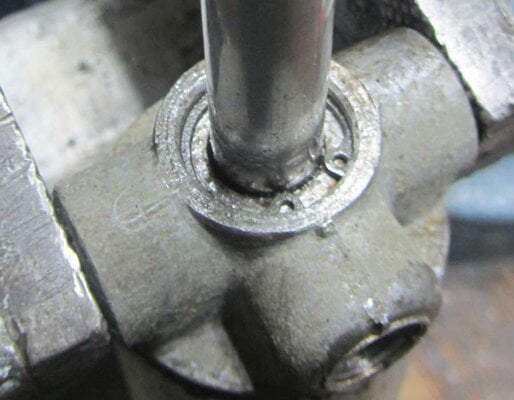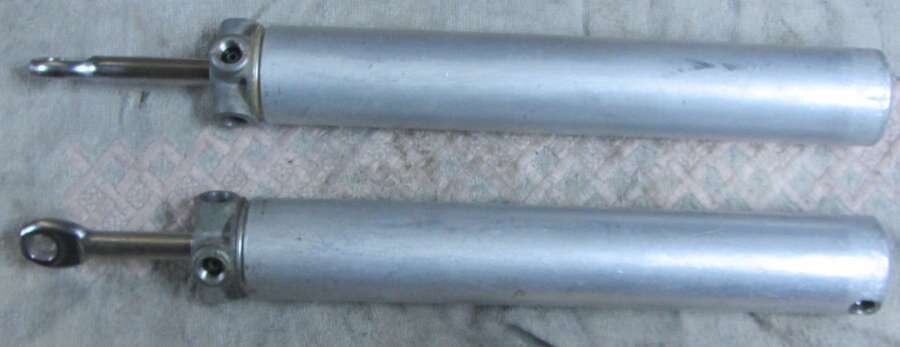About that possibility of those pictures...................................................................
So, due to the need for space, and having limited amounts of it to spare, a long time ago I came up with the idea of making the mouse deck collapsible. As is visible in this shot, the deck is hinged to fold down beside its mounting rail and the rail pivots on a piece of all thread to allow the whole contraption to swing back under the table.
The problem with my design was that the pogo stick pole that I was using to support the mouse deck when it was unfolded and being used had started to develop a tendency to slide out and away, dumping the mouse and the deck and anything else that was present on the floor.
So, in an effort to create better stability for the pole, I dreamed this up. The raw materials came from either one of my scrap bins or from off the work bench; just a short section of angle iron and and a scrap piece of galvanized tube that was cut off a longer chunk that had been cut off a still longer section because it was bent. This kind of angle is not the extruded version with very sharp bends and tight angles, it is more of a product that was either rolled as flat plate through a form or bent to shape in a press of some kind. The shape is uniform but the angles are soft and often not exactly 90 degrees. Working with this stuff in the past, I often had to tweak the angle by smacking it with a very large hammer to get the sides to more closely approximate a true 90.
The pogo stick and the bracket, shoe, Tee plate, whatever whatcha-ma-call-it.
Assembled. They are a tight slip fit so if needed they can be taken apart again.
And set into position.
The deck with the mouse tray and rubber pad added to it as well as, of course, the mouse, complete with tail. (Insert tasteless joke or one liner here). it all comes apart to be put away until needed again.
On to the second widget. I needed a hook to attach to the upper side of the upper Hutch that sits on the top of the first work bench for my Indian project that I made for the basement. The shots for that are around here somewhere in another thread. Nothing special, just a way to support an extension cord and keep it up and out of the way.
The shots are blurry but at this point the hook is just welded and no work has been done to dress down and smooth out the welds. No pictures of that to share but the assembly has already been finished, located, and installed. Pretty wasn't really an objective here; it is up in the rafters, almost, so no one gets to see it or even ever thinks to look for it. Being held in place with a #8 RH wood screw, it can be removed and re-situated if/as needed.
So a post or more ago, I commented on having to create a pair of fender mounting brackets from scratch using some vintage flat bar that I had available to me. One of the problems that i encountered was the need to shape the transition from the bottom of the fender as the bracket ends rose to run parallel to the fender walls. Getting this curve laid in correctly proved to be a MONUMENTAL PITA. and the work required multiple attempts to finally get it right.
What i ended up creating was a forming tool for which I used a short stump of 1-1/2 inch round bar, yet another leftover that had been gathering dust on the bench and getting periodically moved from one bench to another to get it out of the road. At that point if was just the chunk, with the flat strap wrapped around it, and the whole business clamped in the vice. Gave good curves but was miserable to get jigged into place as the round bar would move while you were trying to lock the vice down.
The solution, as shown in these pictures, was to marry, read weld, the round chunk to a short length of small angle; again, an orphan from the scrap bin. I offset the angle by its own wall thickness in relation to the round bar to achieve a better degree of alignment between the jaws of the vise and the curve of the round chunk.
And this is how it fits into the vise. The upper edge of the piece of round bar stock, well, call it an anvil?? lays perfectly flush and even with the upper edge of the jaw of the vise. It can be slid sideways between the two jaws as needed. I may shorten one edge of the angle to be able to work a tighter curve at some point, or make another one by way of creating a pair that would allow me to consider compound curves.


And this is what making that forming tool was all about. What you see here is the final shape for the front fender bracket that, when installed, will accept the forward pair of fender braces or straps.. The fender itself is somewhere between 78 to 83 years old!! OEM, 194? vintage Indian Chief. The visible paint is original to the component; recall mentioning elsewhere that I had given some consideration to an attempt at identifying a paint code for this but thought it was probably going to be a war era DuPont Code and not easy to locate a formula or mix recipe for. All the black Sharpie lines are just by way of identifying the internal centre line of the fender for purposes of making the bracket symmetrical from side to side as much as possible. The clamps are just there to hold it in position and keep it from getting lost. Y'all know how that one works.

This last image, well, I needed a wire wheel that had a small enough diameter that it would fit down into the inner diameter of a fork tube so that I could clean out the surface rust and crap that had accumulated over the decades. This one started life as a 1-1/2 inch dia tool. By virtue of gently introducing it to a grinding wheel, I managed to reduce the diameter overall to around 1-1/4 inch +/-. It worked quite well, until it didn't. The extension rods were turning but it wasn't. Came to find out that the wheel is not any more solidly connected to its mandrel than a quick shot in a press can achieve. Most of the connection is basically friction. So me, preferring a more mechanical connection, elected to see if I could set a couple of tacks at low heat to see if I could make the relationship between wire wheel and mandrel a more permanent marriage. One big concern was to keep the tacks as small as possible to avoid any damage to the wires. Another was the presence of the Cad coating that these accessories somehow almost always seem to possess. Great for rust protection, pita when trying for a tack and dodging the fumes in the process. What you see is what I got out of the deal. (PS on this is that I did buy a pair so there is an heir and a spare, jic y'know??)
PS on the forming tool is that I still have another fender bracket to shape, that being the one that gets located low at the rear of the fender, so still more work left to do. For anyone wondering about my Monte Project, it can be found under the thread title of Project Regress, with some of it spilling over onto the "What did You do to your G-body project today" thread, as well. The absence of a truly warm shop, due primarily to the outrageous cost of Natural Gas right now, has put a hold on most of the winter to do items for it. i still have to clip the rear exhaust ends to match the old ones and assemble them to the rest of the post muffler tail pipes so that is pending.
Later, CopperNick.






































